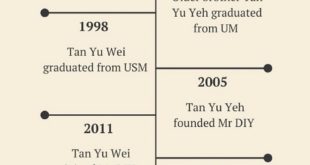Launched in December 2017, BlueSG offers an affordable and convenient mobility option to Singaporeans with its electric car-sharing service.
It is a subsidiary of the Bolloré Group, which launched the world’s largest car-sharing service Autolib’ in Paris.
Now, BlueSG is the world’s second largest electric car-sharing service.
It currently has a fleet of 667 shared electric Bluecar vehicles and 1,487 charging stations that is spread across 374 locations islandwide, from public housing, to city centre and commercial estates around Singapore.
When it first started out however, it only had about 80 Bluecars and 30 charging stations.
“We’ve come a long way,” said Franck Vitte, managing director of BlueSG, as he recalls their business journey.
Changing The Perception Of EV Among S’poreans
BlueSG was pretty much the pioneer of car-sharing services in Singapore. It was a fairly new concept when they first started out, so people had no idea what to expect.
Car-sharing was pretty unknown, and there were probably less than 10 electric cars in Singapore at the time.
Many years ahead, Singapore is still lagging behind (in terms of electric vehicle adoption), to be honest. But I believe that BlueSG played a big part in the change of mindset.
– Franck Vitte, managing director of BlueSG
Since people were so unfamiliar with the concept of car-sharing and electric vehicles back then, they had to educate the population about the benefits and how to use it.

“The very first challenge was to get people to understand it and make it work for them,” he added.
Because people didn’t understand what BlueSG was about at first, staffing also was rather challenging at the start.
The other challenge lies in building the EV infrastructure, namely the charging stations and parking lots.
We needed to have an administrative authorisation from the political grassroots and advisors, who have to authorise us to be stationed in a particular HDB carpark.
It was very hard for us to convince them and in the beginning, many car owners complained that we took up four parking lots at each carpark. We spent a lot of time explaining what we do, but people are now very happy to have BlueSG around and authorisation is much easier.
– Franck Vitte, managing director of BlueSG
“Pay Per Use” At S$ 0.33/Minute
So how exactly is BlueSG different from other car-sharing services in Singapore?
First and foremost, BlueSG owns a fleet of electric cars, which are more environmental-friendly.

Secondly, which is also the “most important” according to Franck, BlueSG focuses on the “point A to B” service. This means that you don’t have to return the car at the same location you picked it up.
Most other car-sharing services adopt the “point A to A” model however, which is not very convenient and it feels like you are renting a car instead, pointed out Franck.
Additionally, with BlueSG, you are billed for the journey — it’s “pay per use”, he summed up.
You only need to pay for the trip duration, which costs S$ 0.33 per minute.
If you were to book a BlueSG car for a whole day, the cost will work out to about S$ 475 a day (S$ 0.33 x 60 minutes x 24 hours). This may sound super expensive, but our system is such that you only pay for as long as you drive.
From Jurong West to Changi Airport — that’s quite a long drive, but the trip only costs about S$ 10. It’s very affordable because you stop paying when you reach your destination. You don’t have to pay for petrol or parking fees.
– Franck Vitte, managing director of BlueSG
With car-sharing, you also don’t have to bear the cost of a maintenance or insurance of your own vehicle, he added.
BlueSG also offer rental packages. Currently, a two-hour package goes for S$ 29.90, three hours go for S$ 39.90, while five hours go for S$ 49.90.
To book a BlueSG car however, you need to first be subscribed to their membership plan.
“We definitely need to have a membership because it’s a car,” stressed Franck.
“We have to make sure that the people have a valid driving license, are over 20 years old, and have their credit or debit card in order to be able to enjoy our service. There’s no other way. It’s not like you’re a buying a McDonald’s (meal),” he said with a laugh.

BlueSG currently offers two different types of membership plans, with a one-month free trial for new customers.
A Basic plan costs S$ 8/month, while a six-month Premium plan costs S$ 18/month.
Their flat rate of S$ 0.33 per minute is unlike taxi or ride-hailing companies, which charge a dynamic pricing.
“They increase their prices when there’s high demand, but we cannot do that. It just doesn’t make sense,” said Franck.
“We offer very minimal, very transparent pricing with zero hidden costs.”
The last differentiating factor that sets BlueSG apart is probably the scale of their network.
“Wherever you are, we can guarantee that a BlueSG station is nearby and within a five-minute walk, more or less.”

In fact, Franck cited their huge network of charging stations to be the turning point that helped to spike the business growth.
Convenience is a key factor for car sharing, and having a sufficient network helps to generate users.
He added that their best marketing approach to date is not mass media, but word-of-mouth.
When people try out BlueSG and like the service, they pass the word on and recommend it to their circle of family and friends. That’s how the number of BlueSG’s subscribers have grown to over 80,000 today.
Fostering Responsible Usage Among Users
Franck refused to disclose BlueSG’s funding figures, though he hinted that the “investment is huge”.
This is not surprising, he says, since their assets are big-ticket items like cars and the construction of charging points is also significant.
A car is indeed a hefty purchase, so what happens if a user dirties or damages their car?
Franck simply said that their network of cars are “highly connected”.
For example, when there’s an accident, it will trigger an alarm so BlueSG will be alerted about it on their end. They will contact the user involved in the accident, and do the necessary insurance follow-ups.

When it comes to the cleanliness of the cars, all users are asked to rate the car’s cleanliness first before they drive off.
When you start your car, the very first thing that will appear on the screen is a (prompt for you to) rate the cleanliness of the car.
If a particular user complains about it, then we will go after the previous user. We will give them a warning and advise them to be considerate of other users. There’s also the possibility of terminating their membership if it persists.
– Franck Vitte, managing director of BlueSG
However, Franck said that BlueSG users have been very responsible so far and they have yet to encounter any major user problems.
Why EV Car-Sharing Will Thrive In S’pore

When Franck first approach the government to propose BlueSG’s business idea, he told them that Singapore would be a perfect place for the service.
The number of cars here are limited and because Singapore is a modern city, we have a big infrastructure. Singapore was just very fitting in terms of space and population.
Also, Singapore is a safe country so we are confident that users will help maintain the car and be respectful.
– Franck Vitte, managing director of BlueSG
He added that not everyone has access to a car, and Singapore has a very good public transport system in place.
While many may think that BlueSG is competing against public transport, it’s actually far from the truth.
“If there’s no public transport, we’ll have more cars on the road and nobody will use car-sharing. Therefore, our car-sharing service and public transport actually complements each other,” he explained.
Although the local public transport in Singapore is already well-connected, a car is undoubtedly more convenient, pointed out Franck.
For instance, you can use it to pick your kids up from school, run errands or go on shopping sprees without having to worry about lugging back your heavy shopping bags.
“Our car-sharing service is also available 24/7, so you can book a car anytime, anywhere.”
Moreover, the Singapore government is strongly pushing for EV adoption which carves a huge business opportunity for BlueSG.
Earlier this year, the Singapore government announced that it will be phasing out internal combustion engine (ICE) vehicles by 2040.
It also recently issued tenders to deploy more EV charging stations across public carparks in Singapore.
When asked if they are worried about the pandemic affecting their business, Franck admitted that it did impact their ridership levels during the circuit breaker.
“During circuit breaker, people were requested to stay at home. When you stay at home, you don’t need the car. Our car ridership dropped by about 40 per cent.”
But as soon as they entered Phase 1 and 2 (of reopening), their ridership bounced back to pre-pandemic levels.
Car Ownership Is Their Biggest Rival

Sharing future plans, Franck said that increasing their car fleet is definitely on the business map.
They also want to offer more convenient options for users with their rental packages, and try to strike a lot of corporate partnerships that can help elevate the brand.
When asked about strategies of surviving in this competitive market, Franck drew business lessons from Smove’s exit from the car-sharing market earlier this year.
He observed that they had adopted the “point A to A model”, which can be troublesome for some users.
“Of course, they tried to make it more convenient for users by allowing them to drop the car at another location. Someone from Smove’s operation (team) would then have to move the car to the original location,” said Franck.
“This is extremely costly when it comes to manpower, and their operating costs were way too high for them to break even.”
What BlueSG did differently is that they “invested massively” at the beginning.
We made sure to install sufficient charging points. Our users can drop off the car anywhere, as long as it’s a location that is a charging station.
The users are the ones moving the cars, and the balancing of the fleet is done by the users themselves.
– Franck Vitte, managing director of BlueSG
Regardless, Franck expressed his regret at Smove’s unexpected departure.
As a fellow car-sharing operator, he knows that what is important for the benefit of the company is for the people to change their mind about the ownership of a car.
“Car ownership is our biggest competitor in fact. It’s not public transport, not the other car-sharing services, or even ride-hailing,” he stressed.
It’s a good thing that car ownership in Singapore is so expensive, he added with a laugh.
“If you don’t want to spend so much on a car yet want to have the convenience (of mobility), without the hassle and cost of car ownership, then BlueSG makes the most sense.”
Featured Image Credit: BlueSG



